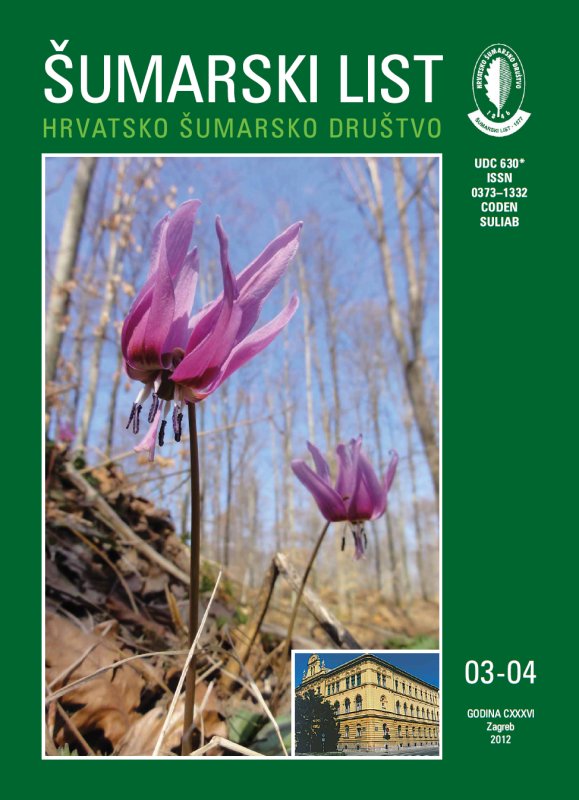
broj: 3-4/2012
pdf (7,00 MB) |
|
||||||||||||||
| RIJEČ UREDNIŠTVA | ||
| Uredništvo | ||
| CROATIAN FORESTRY AT THE CROSSROADS pdf HR EN | 117 | |
| IZVORNI ZNANSTVENI ČLANCI | ||
| Maja Jurc | UDK 630*453 (Phyllonorycter issikii) (001) | |
| The Lime leafminer (Phyllonorycter issikii) in Slovenia pdf HR EN | 119 | |
| Ivan BALENOVIĆ, Ante SELETKOVIĆ, Renata PERNAR, Maša Zorana OSTROGOVIĆ, Anamarija JAZBEC | UDK 630*521+522+531 (001) | |
| Regression models of dbh estimation for photogrammetric maesurement pdf HR EN | 129 | |
| Győző F. HORVÁTH, Dávid SCHÄFFER, Ákos POGÁNY, Dániel TÓTH | UDK 630*451+411 (001) | |
| Spatial distribution of small mammal populations in Drava floodplain forest pdf HR EN | 141 | |
| Tzvetan ZLATANOV, Ivaylo VELICHKOV, Georgi HINKOV, Margarita GEORGIEVA, Olafur EGGERTSSON, Saevar HREIDARSSON, Magdalena ZLATANOVA, Georgi GEORGIEV | UDK 630*561+114 (Castanea sativa Mill.) (001) | |
| Site index curves for European Chestnut (Castanea sativa Mill.) in Belasitsa mountain pdf HR EN | 153 | |
| Bojana KLAŠNJA, Saša ORLOVIĆ, Zoran GALIĆ | UDK 630*232:232.4+238 (001) | |
| Energy potential of poplar plantations in two spacings and two rotations pdf HR EN | 161 | |
| PREGLEDNI ČLANCI | ||
| Igor ANIĆ, Šime MEŠTROVIĆ, Slavko MATIĆ | UDK 630*902 | |
| Important events in the history of forestry in Croatia pdf HR EN | 169 | |
| Abstract: The purpose of this article is to elaborate on the relationship between man and forest in Croatia in the context of historical development of the forestry science and profession. To facilitate reading, the article makes use of list with some important years and events that marked the history of the man–forest relationship and the history of forestry in Croatia in particular. Each event is accompanied by a brief description of its features and data source. The goal is to illustrate the Croatian tradition of the profession, education and science of forests and forestry. This is one of the unique features that we bring into the European Union; the feature that past generations have managed to preserve and guard, taking account of forest sustainability and resources.
Forestry as a science appeared in the 18th century. Its occurrence marks the third period in the man–forest relationship. It sprang from the need for the sustainable use of forest resources and the preservation of forests after deforestation (disappearance of water springs, onset of torrents, soil erosion, formation of bare rock, decrease in soil fertility, loss of forest resources) resulting from intensive cutting operations in the 17th century and the first half of the 18th century. This is the reason that forestry is defined as a science, profession and art of managing and preserving forest ecosystems, whose purpose is to secure permanent benefits to man, society and nature. Forestry is based on the principle of sustainability; defined in 1713, it is still the only proper example of sustainable development and sustainable management. The first written documents that regulate the relationship between man and forests in Croatia date from the 12th century. Forestry in Croatia was established in a very short period in the second half of the 18th century. It all began with the first forest inventory and mapping (1764), the foundation of forest offices (1765 in mountain region, 1773 in lowland region) and the first legally binding Regulation (1769) which introduced sustainable forest management in Croatia. The establishment of the first forest offices as the basic units of the profession can be considered as the official beginning of the development of forestry in Croatia. In three years, Croatian forestry will mark an important jubilee: two and a half century of its existence. In 1846, forestry professionals gathered within the forestry association of the Croatian Forestry Society, which began issuing its scientific-specialist and professional journal Šumarski List (Forestry Journal). The development of the profession was closely followed by the development of higher forestry education. In Croatia, forestry education was provided by vocational schools as early as 1860 and by the University of Zagreb since 1898, after theology, philosophy and law. Forestry is a complex activity that integrates biological, ecological, technical and economic components. It is for this reason that the beginnings of some scientific fields in Croatia emanate from higher forestry education programmes. Forests are the only Croatian self-renewable natural resource and national treasure. They are the source of drinking water, clean air, natural soil, flora and fauna, biodiversity, naturalness, mild climate, attractive landscape and wood material, or in one word, of life itself. As set down in the Constitution of the Republic of Croatia, forests rightly enjoy the status of goods of special interest that have particular protection. Every government in power has been acutely aware of the importance of forests and forestry and has carefully guarded and fostered them. It is no wonder, therefore, that the provided overview contains a set of laws and bylaws, regulations, instructions and directives that relate to forest management. Until recently, the importance of forests was also reflected in the name of the competent ministry, which always contained the word "forest" or "forestry". Forestry was born in the most forested part of Croatia, where it began its two-and-a-half-century long development. It is precisely here that high-quality, productive, and natural forests are still growing. The profession has adhered to scientific principles and regulations to create these forests by applying regeneration and tending operations. The existence, structure, the level of naturalness and biodiversity of these forest ecosystems are the product of Croatian forestry. Key words: Croatia; history of forestry | ||


